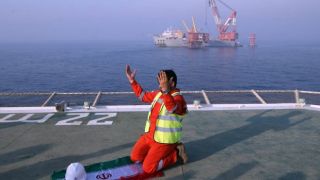Despite the United States’ “successful” talks with China, the tensions over the Korean Peninsula are still high, with the White House putting more pressure on North Korea.
Despite the Americans’ optimism, their talks with the Chinese were not a success. In fact, Xi Jinping has just confirmed the agreements reached by the previous U.S. administration, while some of the “fresh” initiatives (like enhanced opportunities for mutual investments) benefit mostly the Chinese. The latter do not seem to be ready for drastic concessions. Donald Trump may try to force them and his methods are tough. One of them we recently witnessed in Syria. The strike was welcomed by almost all politicians in the United States. In Shayrat, unanimity was not absolute, but if Trump decides to strike North Korea, it will be absolute as the decades-long policy to demonize the Kims regime have shaped very specific views in Washington and nobody would mind a limited unpunished aggression, in other words, a “splendid little war.”
Can North Korea protect itself from a missile strike? No, it can’t. The North Koreans’ anti-missile forces are almost equivalent to those Libya had before the intervention. The North Koreans’ advantages are their air defense artillery, mountains and developed fortifications.
They have almost no chances to strike back the U.S. planes. Their air forces are almost the same Syria had before the war (just 35 MiG-29s) and they are short of highly qualified pilots and fuel.
Their navy has just 34 missile boats with anti-ship missiles – the vessels that were already inefficient at the times of the Vietnam war - and 26 very old Diesel-electric submarines. In other words, the North Koreans will not be able to strike the enemy far from their shores.
China and South Korea object to any aggression against North Korea. The North Korean army is not able to invade South Korea but may well “organize” a borderline conflict. And the South Koreans are among those who are supposed to pay the Americans for protection they don’t need. Paradoxically, the South Koreans have become hostage to fancies they have relayed to the West for decades.
But there are some very important long-term factors that the U.S. administration can’t ignore and therefore will not let Trump wreck Washington’s agreements with Beijing. The Americans have very little time for wiping North Korea away from the map without being punished.
Let’s look what is going on on the Korean Peninsula. According to the general belief, it is divided between a militarist regime with almost 1,000,000-strong army and a peaceful prosperous democracy. But the reality is a bit different.
North Korea has never had a 1,000,000-strong army. Before 2012, it had 900,000 soldiers but in 2013, it already had 300,000 ones. Today, it has 450,000 soldiers, 300 tanks and 35 planes. In contrast, South Korea has 1,027 K-1 and 484 K1A1 tanks, 225 F-15Ks and F-16Ks, 12 destroyers, 24 frigates, 28 corvettes and 18 submarines. In other words, the southern democracy is much better armed than the northern totalitarian regime. So, it is not Seoul that should be worried.
The North Koreans reacted by total mobilization. The Kims’ strategy was to get efficient deterrent weapon, to cut the army and its costs and to focus on the economy. The problem of Washington, Tokyo and Seoul is that Pyongyang is quite consistent and efficient in implementing this strategy.
It has very little plutonium and has no chance to get more. Some 8-10 Hiroshima-type bombs are not a good deterrent unless the target is a Japanese wooden town of the times of WWII. But the North Koreans seem to have managed to go out of the plutonium trap and to have tested a thermonuclear bomb. It may be small but it is not a fake. So, Pyongyang has all chances to produce a 1-megaton bomb and to get a real deterrent weapon.
The North Koreans have also tested a ballistic missile for submarines and its surface analogues for mobile ground submarine systems. They also have missiles that can hit a lot of targets.
The growing number of long-range rockets means that their key potential target is not South Korea (and the South Koreans know this) but the U.S. military bases in the region, including the one on Guam.
This makes it much harder for the Americans to spread democracy in the north of Korea.
Today, North Korea is no longer the hungry state of the 1990s. Today, it is a China-type fast growing economy. And if this growth continues, in near future, North Korea will no longer be vulnerable to U.S. military interventions.
On the other hand, this is a “bad” example for the others – ensuring one’s security by developing nuclear arms - while for some other countries (Ukraine and Syria) the handoff of mass destruction weapons was an entrée to a collapse. For the Americans, who are losing their global hegemony, this is a serious challenge.
Yevgeny Pozhidayev, specially for EADaily
 Russia is ready to transfer $1 billion from frozen Russian assets to the "Peace Council"
Russia is ready to transfer $1 billion from frozen Russian assets to the "Peace Council" And they said: "Daddy"... In Davos, Trump made an attempt on Iceland
And they said: "Daddy"... In Davos, Trump made an attempt on Iceland Well, hold on: Donald Trump arrived at the WEF in Davos — there is a stir there
Well, hold on: Donald Trump arrived at the WEF in Davos — there is a stir there Inside the ex-press secretary of Zelensky — when and how the conflict will end on Ukraine
Inside the ex-press secretary of Zelensky — when and how the conflict will end on Ukraine The Pugacheva and Galkin Union* has expired?
The Pugacheva and Galkin Union* has expired? US seizes Russian tankers during negotiations with Russia — Tsarev
US seizes Russian tankers during negotiations with Russia — Tsarev